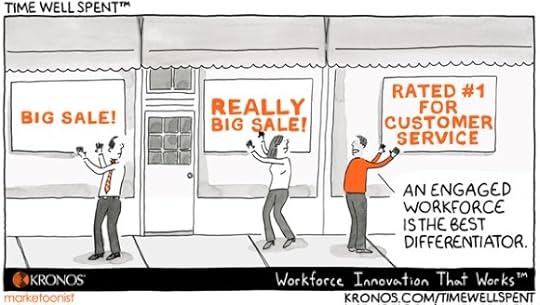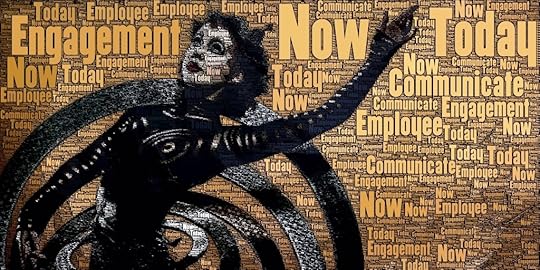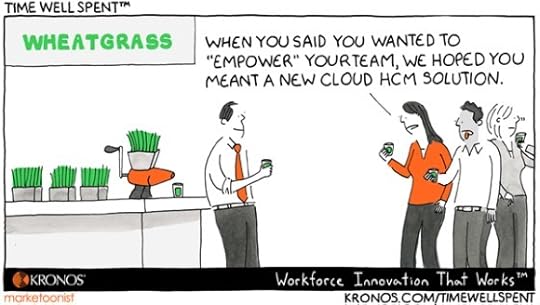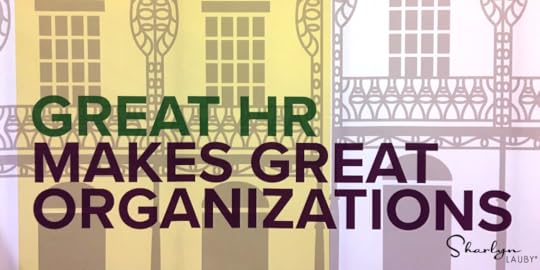Sharlyn J. Lauby's Blog, page 134
July 9, 2017
4 Ways Managers Can Create the Work Conditions for High Performance
One of the most important responsibilities we give to managers is employee performance. Organizations ask managers to set performance standards, communicate those standards, and train employees to deliver. Creating high performance isn’t a goal; it’s a key component of a manager’s job.
Frankly, it’s a big job. Sometimes, it’s easy to forget that. We talk about “Managers need to do this…” or “Managers must do that…” Truth is, managers need to focus on creating the conditions for high performance.
During this year’s SilkRoad Connections Conference, Mollie Lombardi, co-founder and CEO of Aptitude Research Partners, outlined a great roadmap for building high performance.
I think we’ll all agree that the conditions for high performance are those traditional talent management activities such as hiring, learning, goal-setting, and feedback. That’s the easy part! The tough part is, how do we use these talent management activities to create high performance. Lombardi recommended four strategies:
Alignment: For high performance to exist, it must be in alignment with organizational strategies, goals, and objectives. Organizations need to agree on employee performance, both in terms of what meets the standard as well as the defined goals of high performance.
Experience: Employees should be involved in the performance process. They need to give and receive feedback about performance. Employees will perform at a high level when they can personalize their work and have control over the way it gets done. That includes being able to simplify work processes when it makes good business sense.
Coaching: Organizations should provide managers with training so they can effectively coach employees. Coaching isn’t something that’s only done to when an employee is performing poorly. Managers have the ability to offer positive feedback and coaching to employees so they will perform at a high level.
Technology: We’ve heard the saying before, “more isn’t always better.” Organizations should use technology strategically to help with administration. Today’s technology solutions can help with succession planning, collaboration, learning, and performance management. More technology doesn’t mean better technology.
Every organization wants high performance from employees. To get high performance, managers need to play an active role in talent management. They have to hire the best, train them well, set relevant goals, and coach. The way that managers excel in talent management is by creating alignment, encouraging employee experiences, coaching regularly, and using technology strategically to assist.
Image captured by Sharlyn Lauby after speaking at the SHRM Annual Conference in Washington, DC
The post 4 Ways Managers Can Create the Work Conditions for High Performance appeared first on hr bartender.






July 7, 2017
Your Employees Are the Company’s Secret Weapon – Friday Distraction
I know sometimes it sounds like a broken record to talk about employee engagement. Truth is, for all of the conversation, it doesn’t appear that organizations are moving the needle. Gallup has been tracking employee engagement since 2000 and, for the most part, the numbers have stayed pretty consistent. Less than one-third of employees are engaged in their work.
However, I believe the best argument for why organizations need to make employee engagement a priority might be today’s Time Well Spent from our friends at Kronos.
Let’s face it. We love good customer service. Even when companies make mistakes, we’re secretly hoping they make it right.
Now I will not lie. I love a good sale. But sale prices come and go. There’s only so much frustration I will take for a good sale. On the other hand, for good service…I will spend more. I’m a sucker for a good upsell.
That’s why organizations need to make employee engagement a priority. Engaged employees deliver excellent customer service. There are plenty of people out there just like me who will spend more to be treated well. And spend even more with a good upsell. That’s how organizations make money, increase market share, and dominate their industry.
The question becomes, are organizations making the connection between engagement and customer service? Here are a few things to consider:
Every employee should receive customer service training. No matter what role you have in the organization, you have a customer. Employees would benefit from a little customer service training during orientation or onboarding. Make sure employees understand the lifetime value of a customer and their role in customer service success.
Empower employees to handle mistakes quickly and efficiently. I’m amazed when employees have to ask for permission to write off less than $5. Especially when the lifetime value of a customer is $20,000. I understand that organizations don’t want to give employees carte blanche, but working parameters can and should be set.
Share customer stories throughout the organization. I once worked for a company that kept track of how many customer letters they received. Their goal was to receive two good letters for every bad one. And we did. But it took sharing stories from customers, so employees understood the type of great customer service that would make someone write a letter.
Reward and recognize excellent service. Acknowledge the behavior that you want to see. If employees do something fantastic for a customer, let them know. They will do it again. Don’t make the assumption that the customer will thank the employee for excellent service. It’s true – they will. But the company needs to do it too.
Bottom-line: Engaged employees deliver excellent customer service. And excellent customer service translates into better business.
The post Your Employees Are the Company’s Secret Weapon – Friday Distraction appeared first on hr bartender.






July 6, 2017
A Senior Management Change Can Interrupt Company Culture
A key theme during this year’s Great Place to Work Conference was developing talent. Are organizations asking their managers the question, “What are you doing to develop talent? And specifically, your replacement?”.
You know I’ve always felt the primary role of a manager is to hire and train their replacement. It goes without saying that a big interrupter can occur in company culture when there’s a change in management. Organizations don’t always get to plan for management changes, so when they do, it’s a big deal. It’s a visible process that demonstrates whether the company really lives their culture.
During the conference, Plante Moran Managing Partner Emeritus Bill Hermann and current Managing Partner Gordon Krater shared their formula for successfully transitioning management responsibilities. The firm is the 14th largest certified public accounting firm in the U.S. It has over 2,000 employees and has been recognized as a “best place to work” by Fortune Magazine for 13 consecutive years.
Their transition took 8-9 months. Let that sink in for a moment. Almost a year. Now I will admit that some of it could be attributed to the position of managing partner. But after hearing Hermann and Krater share their story, I can easily see the successful transition of managers taking months. Emphasis on the word “successful”.
The reason I say that is because of how they defined the goal. The goal of transitioning management responsibility was for the incoming and outgoing managers to maintain credibility. Both of them. Equally.
So many times, when we think of transitioning management, it’s because one person is leaving the company. In this situation, Hermann wasn’t leaving. He just wasn’t going to be managing partner anymore. It could hurt the organization if the transition didn’t preserve the individual’s credibility.
In today’s work environment, we are going to be faced with more situations where a manager transitions and doesn’t leave the company. Maybe they move to another department, division, or position. Maybe they retire and come back as a part-time consultant. Organizations have to put more thought into the transition process. Hermann and Krater shared three phases to a successful management transition that apply at any level of the organization.
Become knowledgeable about the company. This might seem like the easy part because it includes understanding the financials and the business. It might involve some technical training. But knowledge of the company means giving individuals the experience they will need in a future role. It’s allowing them to make mistakes while gaining knowledge. Remember the goal of maintaining credibility while creating a teachable moment. It can be tricky.
Take responsibility for the organization. Great managers should try to leave the organization better for their successor. They don’t “kick the can down the road”. They take care of business and do what’s in the best interest of the organization. Once a successor has been identified, managers need to step aside so the successor can start to assume responsibility. But not step so far into the background that it appears the new manager isn’t getting the support they need to be successful.
Maintain the company culture. I’d like to think we all know that culture is the number one reason people come to work for our organizations and the number one reason they leave. Managers should not only act in the best interest of the organization but also its culture. For example, in organizations where employees know the founder and remember the early days, it can be hard when a new manager takes over the reins. New managers need to understand and preserve the culture.
A lot of organizations do Phase 1 and 2 well. Managers know the company and their responsibility. It’s the culture component that can derail their success. Company culture is made up of those moments of truth about who the company hires, promotes, recognizes, and fires. If you want to learn more about how to maintain company culture during a management transition, check out Hermann and Krater’s book, “Succession Transition: A Roadmap for Seamless Transitions in Leadership”. It’s a super easy read that can provide a little creative inspiration for your organization.
Image capture by Sharlyn Lauby on the streets of Charlotte Amalie, St. Thomas USVI
The post A Senior Management Change Can Interrupt Company Culture appeared first on hr bartender.






July 2, 2017
Employee Engagement: The Best Time To Do It Was 20 Years Ago
Mr. Bartender mentioned what is believed to be an old Chinese Proverb the other day. “The best time to plant a tree was 20 years ago. The second-best time is now.” It reminded me that the same philosophy applies to employee engagement.
The ideal time to deal with engagement was decades ago. Developing organizational culture takes time. Training managers takes time. But you know that. So, what do you do if employee engagement hasn’t been priority number one?
Don’t let it keep the organization from taking action. Like the proverb says, “the second-best time is now”. Here are seven tips and resources to get you started:
Start with a definition. I believe many organizations struggle with employee engagement because they don’t know how to explain it. Ask yourself: If I had to explain employee engagement in one sentence, what would I say?
RESOURCE: Employee Engagement Defined
Get the entire company onboard. With all the talk about “full employment”, employee engagement is more important than ever. Retaining and attracting the best employees requires a great company culture. And that’s everyone’s job.
RESOURCE: Employee Engagement Is Everyone’s Job
Train managers and employees to communicate well. Feedback and one-on-one meetings are more important than ever to grow engagement and improve employee retention. But those things don’t always come naturally. Give managers and employees the tools to communicate.
RESOURCE: Increase Employee Engagement and Retention with Better 1:1 Meetings
Build engagement strategies into company culture. Businesses want an engaged workplace culture. That starts before an employee’s first day on the job. Our friends at Kronos show us the essential elements of a highly engaged culture.
RESOURCE: A Highly Engaged Workplace Culture – The Essential Elements
Take a pulse on the work environment. We know the value of employee engagement and using surveys to develop programs. Proper planning and execution is crucial in employee engagement surveys. Our friends at Readex share four survey planning and execution strategies.
RESOURCE: Employee Engagement Surveys – 4 Planning Must-Haves
Tell your company story to candidates, employees, and customers. Storytelling has become the cornerstone of marketing. So, it’s no surprise that storytelling can be effective in growing employee engagement. A few tips.
RESOURCE: Use Storytelling to Create Employee Engagement
Measure your results! Yes, it’s possible to accurately measure employee engagement. Our friends at Workify have developed Employee Net Promoter Score (eNPS), based on the net promoter score concept, to link engagement and candidate referrals.
RESOURCE: The Key to Employee Engagement is Your Net Promoter Score
Even if your organization has made employee engagement a priority for years, your work isn’t done. Engagement is a top priority – today, tomorrow, and in the foreseeable future. That means it’s not about when you start making engagement a priority, but the fact that you are.
Image captured by Sharlyn Lauby outside the Cirque du Soleil big top in Miami, FL
The post Employee Engagement: The Best Time To Do It Was 20 Years Ago appeared first on hr bartender.






June 30, 2017
Everyone Needs to Change Their Communication Style – Friday Disctraction
(Editor’s Note: Today’s post is brought to you by our friends at Kronos , a leading provider of workforce management and human capital management cloud solutions. For a second year, in information technology by Glassdoor.com. Many congrats to him! Enjoy the post.)
When we’re asked to be a part of something – like being on a project team or getting a promotion or even starting a new job – it’s very tempting to think that “I was selected because I’m good at something. And for that reason, I don’t need to change.” The first part of that sentence is correct. We are asked to participate on teams and projects because we have the skills they need.
Now, let’s talk about the second part. Being able to change isn’t a conversation that only applies to managers. It applies to everyone. For us to effectively get our thoughts across, we need to make adjustments to our communication style. We should listen and communicate in a way that others respond to rather than making others change to hear our message.
Today’s Time Well Spent from our friends at Kronos reminded me that being able to change even applies when it comes to definitions, like empowerment.
Next time you’re trying to communicate a new idea, think about a couple of ways clearer communication can help.
Make sure everyone understands the word. I’m not talking about a grammar police activity. There are many words that, over the course of time, have become catch all phrases (example: disrupt). So, if the organization is talking about empowerment or engagement or some other concept, define it. And define it as it pertains to the organization. It’s difficult to discuss goals and solutions when people aren’t on the same page. This doesn’t need to be a long conversation. It might be as simple as, “Before we begin brainstorming, let’s take five minutes to confirm the company’s definition of empower.”
Clear up misunderstandings. We’re human and organizations are filled with humans, so mistakes and misunderstandings will happen. When the boss starts passing around the wheatgrass shots – much to the employee’s surprise – find a moment to discuss. It’s possible that the boss got the definition and the solution right. But employees heard it differently. Which means there’s still a communication issue to resolve. Go back to the definition to figure out where the communication breakdown occurred.
Communication is a huge and vital part of how we get things done. Yes, our knowledge, skills, and abilities are important too. But we need for others to have confidence in us. We share our ideas, processes, and philosophies. The way we do that is through communication.
The post Everyone Needs to Change Their Communication Style – Friday Disctraction appeared first on hr bartender.






June 29, 2017
The Best Way to Study for an HR Certification Exam – Ask #HR Bartender
I’ve written before about the importance of HR certification and recertification. Today’s reader question has to do with a different part of the process – studying for the exam.
I am interested in obtaining a HR certification and had a few questions for you. What do you recommend is the best way to prepare for the exam besides professional experience? I’ve been in the HR profession for about 4 years now and studied human resource management in college. Do you recommend buying study guides? What about the weekly courses/classes?
First things first, I believe that it’s helpful to study prior to taking a certification exam. That being said, I also believe that study habits are very personal. What worked for me, might not be the best path for someone else. If you’re considering any kind of certification, here are a few things to consider:
Get a copy of the competency guide to understand the exam. The first step to putting together a study plan is knowing what subjects will be covered on the exam. Then, do a little self-evaluation. Are there topics that you know a lot about? Topics you don’t feel as comfortable with? This will tell you how much you need to study and what topics to focus on.
Find study partners to share experiences. The great thing about taking a certification exam is you don’t have to do it alone. There are other people who have taken the exam and people who are studying just like you. See if you can find a group connected to your professional association or on social media – it can help you stay focused on your study goals. And being a part of a study group allows participants to share stories using their practical experience.
Do research about books and tutorials. There are a wide variety of opinions about books and study guides. Here’s my two-cents: I felt that taking a certification exam was just as much about test taking as the mastery of knowledge and skills. So, I like the study guides, books, definitions, tutorials, etc. because I was able to practice test taking. Other people might have a totally different opinion. You’ll have to decide what’s best for you.
Look for affiliated courses and classes. Like books and tutorials, there are many options available. I’ve found there’s a difference between an HR course and an HR certification prep course. Review the course syllabus to ensure you’re signing up for the right program. Also, check with your employer to see if prep courses are covered under tuition reimbursement or professional development.
HR Certification: A Few Things to ConsiderClick To Tweet
Professional certification is a big step. It takes commitment of time and resources to study for an exam. But the rewards are worth it. Not only do you learn as you’re preparing for the exam, but you’re making the commitment to continue learning afterward (as part of recertification.) For those readers who’ve taken a certification exam, what advice can you provide?
Image captured by Sharlyn Lauby after speaking at the SHRM Annual Conference in New Orleans, LA
The post The Best Way to Study for an HR Certification Exam – Ask #HR Bartender appeared first on hr bartender.






June 27, 2017
5 Key Components of Any Successful Performance Management Process
Regardless of your opinion of the annual performance review, organizations still need to have a performance management process. Performance management is a way to provide feedback, accountability, and documentation for performance outcomes. Even organizations that are “ditching” the annual review aren’t abandoning accountability, feedback, and documentation. So, it’s important for organizations to create a process that works for them.
At this year’s Halogen TalentSpace Live, David Mennie, vice president of product marketing and strategy at Saba + Halogen, shared the five essential elements to any performance management process. As he was discussing each, I couldn’t help but wonder how organizational performance would improve if everyone just focused on these five things. That the list David shared was really a roadmap for high performing cultures. Here are the five components:
Management Involvement. It starts here. Managers are responsible for setting performance expectations, providing feedback and coaching, and recognizing excellent work. That doesn’t happen on the sidelines. Managers need to buy into and be an active part of the performance management process.
Goal Setting. High performing individuals and teams have a big hairy audacious goal (BHAG) that drives their performance. And company cultures that place an emphasis on goals align employee performance with that BHAG. The connection creates engagement because employees see how their work helps the company.
Learning and Development. Once goals are set, employees need to have the knowledge and skills to do the work. Companies that want high performance need to make investments in employee learning and development. It will allow employees to accomplish their goals – both now and in the future.
Feedback and Coaching. Employees want to know how they are performing. Because they want to do a good job. Managers should regularly tell employees about their performance – what’s good, what could be improved, and even more importantly, how to evaluate their own work. When employees can evaluate their own performance well, they can set their own goals and begin to become self-learners.
Ongoing Conversations. This component brings the other four items (management, goals, learning, and feedback) together. Organizations should create cultures where having ongoing discussions about performance goals, learning, coaching, etc. are happening.
Now if you’re saying to yourself, “This is a great list. But it’s easier said than done”, you’re right. If the list were easy, everyone would have nailed it by now. We’d all be working on high performing teams. Mastering this list is a journey. The good news is, technology can help support many of these components. But technology isn’t a substitute for training or effective management or accountability. It’s also not a substitute for process. Organizations need to have excellent processes. Those pieces must be in place. Then, technology can effectively support the system.
Organizations cannot let the difficulty of the task keep them from creating a successful performance management process. Not taking the time to define the process isn’t fair to the employee, manager, or the technology.
Image captured by Sharlyn Lauby just off Duval Street in Key West, FL
The post 5 Key Components of Any Successful Performance Management Process appeared first on hr bartender.






June 25, 2017
Recruiters: Do You Know the Quality of Your Web Traffic?
One of the most interesting conversations that took place during this year’s TAtech Spring Congress was about web traffic. According to a report by software company DeviceAtlas, almost half of all web traffic (48 percent) is now generated by bots (aka web robots) and crawlers.
Bots and crawlers are software that’s designed to visit your site and perform a function. For example, there are Google bots that crawl HR Bartender. The bot is helpful because it indexes information. That way, when someone does a search on Google for the “difference between knowledge, skills, and abilities”, HR Bartender shows up in the search.
Unfortunately, there are also not-so-good bots. And this is where recruiters and human resources professionals need to pay attention.
Many organizations use pay-per-click (PPC) or pay-per-applicant (PPA) recruitment advertising. It totally makes sense, right? Organizations only pay for a recruiting source when it delivers results. In this case, when a job seeker clicks through to see the job posting or actually applies.
Here’s the problem. While today’s technology has become very sophisticated, it’s not good enough to distinguish humans from bots. Meaning, when a click happens on your recruitment ad, the computer that’s counting those clicks (the ones that you have to pay for) doesn’t know if a person or bot did it. This impacts you two ways:
You could be paying for clicks made by bots.
You could have more bots than humans applying for jobs.
Either way, it’s not good. And it keeps you from meeting your recruiting goals. But the answer isn’t to eliminate recruitment advertising.
Let’s face it. We need it.
In 2016, TAtech put together a work group to address this issue. During the Congress, they shared their “Declaration on Traffic Quality”. The document is designed to protect advertisers from fake applicants and help organizations better understand web traffic. The document is available FREE of charge in the TAtech bookstore.
The TAtech community has taken this one step further. Recruitment advertising publishers that are committed to bringing accuracy and transparency to this issue are being recognized for their efforts. Think of it like the Good Housekeeping Seal of Approval.
Recruiting advertising is a serious business. I think it’s awesome that the community is creating higher standards for itself. As human resources professionals, we need to stay current with what’s happening in this area. It can impact the success of our recruiting results and our budgets.
Image captured by Sharlyn Lauby after speaking at the Learning and Development League 2016 Annual Conference in Delhi, India
The post Recruiters: Do You Know the Quality of Your Web Traffic? appeared first on hr bartender.






June 23, 2017
All Freelancers Are Not the Same [infographic] – Friday Distraction
We’ve talked often on this blog about the need for organizations to consider contingent workers in their staffing strategy. The contingent workforce includes on-call, temporary, freelancers, consultants, and contractors (just to name a few). But even within these titles, there are differences.
Take freelancers for example. If you Google the definition of freelancer, it says “working for different companies at different times rather than being permanently employed by one company.” By this definition, I’m a freelancer. A full-time freelancer.
But I believe many people would say that a person with a full-time job and a side-hustle does freelancing. Our friends at LinkedIn recently shared this infographic on the five different types of freelancers in today’s workplace.
Organizations are not only going to want to make decisions about hiring freelancers for their business, but they are going to have to decide what kind of freelancer will fit with their operation. I’m not just talking about culture fit – although that is important. Freelancers have to be able to work within the structure of the organization. So, if the company needs their freelancer to stop by occasionally for meeting, can a “side gigger” make themselves available? Or if the organization would like to engage a freelancer for a year, is the “substitute” going to bail on them once they find a job? These are things organizations need to consider. Here are a couple of tips to consider when hiring freelancers:
Think about the type of work that needs to be done. When considering a freelancer for an assignment, think about more than just the task. Will phone calls or meetings be required? Is there the possibility you will want to engage the freelancer again? It might help you decide the best type of freelancer to consider.
Consider short-term and long-term arrangements. Build a relationship with freelancers. It’s a win for everyone. The freelancer gets some semi-steady income. The company gets a person who knows them. That’s beneficial when it comes to getting the work done.
Once organizations understand the type of freelancer they’re looking for, it will make it easier to find the right person. Hiring the wrong freelancer is like hiring the wrong employee. The company will constantly be in hiring mode and training people to do the work.
The post All Freelancers Are Not the Same [infographic] – Friday Distraction appeared first on hr bartender.






June 22, 2017
Everything #HR Needs to Know About Boolean Search
A few weeks ago, I attended the SHRM Talent Management Conference and TAtech Spring Congress. Both events are very heavily focused on talent acquisition, which isn’t a surprise given all of the media attention on “full employment”.
But it made me realize that there are some fundamental tools human resources professionals might not have focused on over the past few years. Like Boolean search.

You know, when organizations were getting hundreds of applications, I can see how refining Boolean search skills wouldn’t be tops on my to-do list. But now, being able to find qualified candidates fast is a priority. So, I wanted to share some information.
To help us know more about Boolean Search, I reached out to Jim Durbin, social media headhunter and founder of Sourcing Worklab. Over the last decade, he’s trained over 9,000 recruiters on the effective use of digital recruiting tools. In addition to his role at Sourcing Worklab, he manages a B2B marketing firm, develops startups in the artificial intelligence (AI) and recruiting space, and takes as many full desk searches as he can get his hands on. I’m thrilled he agreed to share his expertise.
Jim, let’s start with a definition. What is Boolean search and why should HR departments have an interest in it?
 [Durbin] Boolean search is a method for searching websites to limit your results. The method uses Boolean “operators” which are simple words to define relationships between keywords, resulting in a more focused search result.
[Durbin] Boolean search is a method for searching websites to limit your results. The method uses Boolean “operators” which are simple words to define relationships between keywords, resulting in a more focused search result.
Boolean operators are useful in sorting through the large number of profiles, resumes, and pages available online. These operators are used on websites, in our databases, and in much of our software. HR departments should be aware of Boolean because it gives the control of a search to the human being, and not the developers who created the search function.
Just so everyone is on the same page, what are the 4-5 classic Boolean operators that everyone should know?
[Durbin] SITE, INURL, INTITLE, AND, OR and NOT. I had to go with 6. Here are examples of each:
SITE – The SITE command restricts the search to results within just one website. [site:linkedin.com]
INURL – The INURL command restricts the search to characters in a specific website address. [site:behance.net inurl:resume returns only resumes]
AND – The AND command restricts the search to all of your conditions. [“business development representative” AND “medical sales”]
OR – The OR command broadens the search for multiple terms [“sales representative” OR “account manager”]
NOT – The NOT command narrows your search by deleting unwanted terms [Java Developer NOT:recruiter]
Another thing to note: Quotation marks count too. You can use them to limit multiple terms. [“Sales representative” (in quotes) brings less results, but better ones, than sales representative (not in quotes).
For readers looking for more Boolean operators, Dean Da Costa has shared an extensive roundup of resources on RecruitingBlogs.
I’ve been in HR a lot of years. Now that we have more advanced technologies and social media, do people still need to be skilled in Boolean search? Why or why not?
[Durbin] Boolean is a method. Even within most social media platforms, Boolean search is the method we use to search social media. Recruiters still need to be able to control their searches, so yes, they must be skilled at Boolean.
I’ve read a few articles recently about “long” Boolean being outdated and “short” Boolean being better. First of all, what’s long and short Boolean? And in your expertise, does it matter?
[Durbin] Long Boolean are just long sentences. When you searched through the internet, long searches helped you quickly find the few resumes you were looking for.
Short Boolean is a method that is closer to active search. Short Boolean gets you close to your final results, allowing you to make changes. Think of short Boolean as a way to point a ship in the right direction, and long Boolean as the full map of your journey. If you know where you’re going, long Boolean is useful.
Today, you have to be very good to use Long Boolean correctly. The reward is not always worth that effort. I do think the days of long Boolean are over, but short Boolean will continue to be needed to help us guide our steps.
Last question. We’ve talked before on this blog about search engine optimization (SEO) and how a Google algorithm change impacts career site marketing. Do activities like Google changing their algorithm change Boolean search? Are there things that HR pros should watch for?
[Durbin] Absolutely. The Google search algorithms updates like Panda, Penguin, Hummingbird have completely changed career site marketing, and HR has to be aware of this when building career portals, posting jobs, or purchasing software.
Those changes have one major effect: Google specifically is now focused on recent results. This makes research very difficult without using Boolean. This is a general problem, not a specific thing to look out for. What HR pros need is to be able to quickly access information from any database or software as quickly as their competitors. This means becoming expert at searching the internet – and Boolean is still the dominant form of that kind of search.
I want to thank Jim again for sharing his expertise with us. If you want to learn more, be sure to check out Jim’s blog – Digital Marketing Headhunter. Also, you can check out Sourcing Worklab, they are providing live action sourcing, where you learn how to use these kinds of searches on real jobs.
To find the best talent for the organization, HR professionals will need to step up their game. That means trying new things and brushing off some skills we haven’t used in a while.
Image captured by Sharlyn Lauby after attending the 2017 BetterWorks Goal Summit in San Francisco, CA
The post Everything #HR Needs to Know About Boolean Search appeared first on hr bartender.






Sharlyn J. Lauby's Blog
- Sharlyn J. Lauby's profile
- 10 followers












